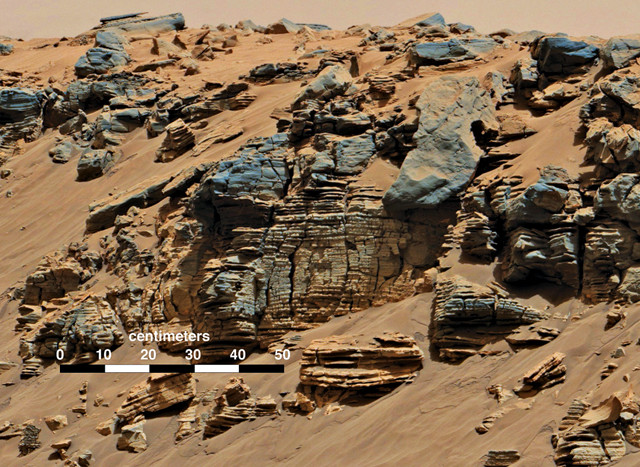
by Timothy Oleson Monday, February 2, 2015

The sediments that formed these laminated rock layers, photographed by the Curiosity rover's Mastcam last August, are thought to have been deposited in a long-lasting lake in Gale Crater. Credit: NASA/JPL-Caltech/MSSS.
With two rovers patrolling the surface of Mars, five spacecraft in orbit above it, and scientists back here on Earth studying the Red Planet from afar, new findings are announced almost weekly. Here are a few of the latest updates.
NASA’s Curiosity rover found evidence that one or more large and long-lasting lakes probably filled Gale Crater in the planet’s warmer and wetter early history. While investigating the lower slopes of Mount Sharp recently at an outcrop called the Murray Formation, the rover photographed thick rock stacks featuring numerous layers of lithified sediment. Such stacks are typical of lake environments, where sediments slowly settle to the bottom and transform into rock over time. Curiosity has observed both wind- and water-lain sedimentary deposits in Gale Crater before, but the thickness of the stacks suggests that lakes in the crater were more persistent than previously thought, perhaps existing continuously, or intermittently, for millions of years, according to a NASA statement. The finding “challenges the notion that warm and wet conditions were transient, local, or only underground on Mars,” said Ashwin Vasavada, deputy project scientist at NASA’s Jet Propulsion Laboratory (JPL).
Atmospheric methane concentrations and sources on Mars — of interest because most methane on Earth is produced by living organisms (although it is formed nonbiologically too) — are notoriously difficult to pin down. Concentration estimates from remotely sensed measurements, collected using both Earth-based telescopes and instruments aboard Mars orbiters, have varied considerably in time and location over the planet’s surface, as well as from one another. And, to date, these estimates do not sync with model predictions of abiotic methane production on Mars due to the breakdown of organic material delivered to Mars’ surface in meteorites and interplanetary dust by ultraviolet light. Now, Christopher Webster of JPL and colleagues have analyzed data collected on the ground over a period of 20 months (roughly one Martian year) by Curiosity to catalog methane levels in Gale Crater. They found a background abundance of just 0.7 parts per billion, far lower than most remotely sensed measurements and roughly a third of what the models predicted. But, they also found that on one occasion, the concentration spiked to 10 times the background level for a period of 60 Martian days. The results imply “that Mars is episodically producing methane from an additional unknown source” beyond those currently accounted for in models, the researchers wrote in Science.
Intense volcanism on Mars roughly 3.7 billion years ago may have helped intermittently warm the planet enough to allow surface ice to melt, particularly at low latitudes, according to a new study in Nature Geoscience. The volcanic outbursts flooded much of Mars’ surface with thick deposits of basaltic lava, similar to, but far larger than, flood basalts on Earth. These outbursts — thought to have occurred every 1,000 to 10,000 years or so over the course of 100 million to 200 million years — also spewed huge pulses of sulfur-containing gases into the atmosphere. Itay Halevy of the Weizmann Institute of Science in Israel and James Head of Brown University modeled the effects of these gases, which aren’t usually accounted for in models of Mars’ early climate. They found that, despite the cooling effect imposed by volcanic aerosols formed from sulfuric acid and dust, each eruption had a temporary net warming effect because of inputs of the greenhouse gas sulfur dioxide. Combined with the warming effect of a thicker atmosphere overall at the time, this extra warming could have bumped temperatures at low latitudes above the freezing mark for tens to hundreds of years at a time.
© 2008-2021. All rights reserved. Any copying, redistribution or retransmission of any of the contents of this service without the expressed written permission of the American Geosciences Institute is expressly prohibited. Click here for all copyright requests.